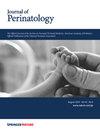Resuscitation after birth and beyond in the neonatal intensive care unit: NRP or PALS?
IF 2.4
3区 医学
Q2 OBSTETRICS & GYNECOLOGY
引用次数: 0
Abstract
Newborns requiring resuscitation present a unique challenge compared to pediatric and adult patients due to the physiological differences at birth. This paper explores the distinction between the Neonatal Resuscitation Program (NRP) and Pediatric Advanced Life Support (PALS) in neonatal intensive care units (NICUs), with a focus on the optimal approaches for resuscitation in newborns. Through clinical studies and case scenario analysis, the paper underscores the importance of ventilation, tailored algorithms, and collaborative resuscitation efforts in NICU settings, focusing on respiratory versus cardiac causes. It evaluates the necessity of NRP over PALS, the resuscitation techniques, and the impact of combining the two protocols. A perspective on the challenges and costs of implementing such protocols has also been discussed.新生儿重症监护室出生后及以后的复苏:NRP还是PALS?
由于新生儿出生时的生理差异,与儿科和成人患者相比,需要复苏的新生儿面临着独特的挑战。本文探讨了新生儿重症监护病房(NICUs)新生儿复苏计划(NRP)和儿科高级生命支持(PALS)之间的区别,重点介绍了新生儿复苏的最佳方法。通过临床研究和案例分析,本文强调了在新生儿重症监护病房环境中通气、量身定制的算法和协作复苏努力的重要性,重点关注呼吸原因与心脏原因。它评估了NRP比PALS的必要性,复苏技术,以及两种方案结合的影响。还讨论了对执行此类议定书的挑战和成本的看法。
本文章由计算机程序翻译,如有差异,请以英文原文为准。
求助全文
约1分钟内获得全文
求助全文
来源期刊

Journal of Perinatology
医学-妇产科学
CiteScore
5.40
自引率
6.90%
发文量
284
审稿时长
3-8 weeks
期刊介绍:
The Journal of Perinatology provides members of the perinatal/neonatal healthcare team with original information pertinent to improving maternal/fetal and neonatal care. We publish peer-reviewed clinical research articles, state-of-the art reviews, comments, quality improvement reports, and letters to the editor. Articles published in the Journal of Perinatology embrace the full scope of the specialty, including clinical, professional, political, administrative and educational aspects. The Journal also explores legal and ethical issues, neonatal technology and product development.
The Journal’s audience includes all those that participate in perinatal/neonatal care, including, but not limited to neonatologists, perinatologists, perinatal epidemiologists, pediatricians and pediatric subspecialists, surgeons, neonatal and perinatal nurses, respiratory therapists, pharmacists, social workers, dieticians, speech and hearing experts, other allied health professionals, as well as subspecialists who participate in patient care including radiologists, laboratory medicine and pathologists.
 求助内容:
求助内容: 应助结果提醒方式:
应助结果提醒方式:


